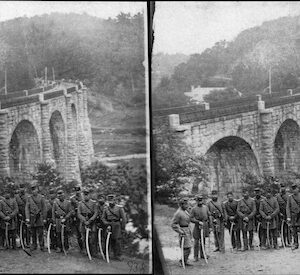Tag: B&O Thomas Viaduct (Patapsco River MD)
 Wikipedia says: The Thomas Viaduct spans the Patapsco River and Patapsco Valley between Relay, Maryland and Elkridge, Maryland, USA. It was commissioned by the Baltimore and Ohio Railroad (B&O); built between July 4, 1833, and July 4, 1835; and named for Philip E. Thomas, the company’s first president. It remains the world’s oldest multiple arched stone railroad bridge.
Wikipedia says: The Thomas Viaduct spans the Patapsco River and Patapsco Valley between Relay, Maryland and Elkridge, Maryland, USA. It was commissioned by the Baltimore and Ohio Railroad (B&O); built between July 4, 1833, and July 4, 1835; and named for Philip E. Thomas, the company’s first president. It remains the world’s oldest multiple arched stone railroad bridge.
At its completion, the Thomas Viaduct was the largest railroad bridge in the United States and the country’s first multi-span masonry railroad bridge to be built on a curve.
Design
This Roman-arch stone bridge is divided into eight spans. It was designed by Benjamin Henry Latrobe, II, then B&O’s assistant engineer and later its chief engineer. The main design problem to overcome was that of constructing such a large bridge on a curve. The design called for several variations in span and pier widths between the opposite sides of the structure. This problem was solved by having the lateral pier faces laid out on radial lines, making the piers essentially wedge-shaped and fitted to the 4-degree curve.
The viaduct was built by John McCartney of Ohio, who received the contract after completing the Patterson Viaduct. Caspar Wever, the railroad’s chief of construction, supervised the work.
The span of the viaduct is 612 feet (187 m) long; the individual arches are roughly 58 feet (18 m) in span, with a height of 59 feet (18 m) from the water level to the base of the rail. The width at the top of the spandrel wall copings is 26 feet 4 inches (8 m). The bridge is constructed using a rough-dressed Maryland granite ashlar from Patapsco River quarries, known as Woodstock granite. A wooden-floored walkway built for pedestrian and railway employee use is 4 feet (1 m) wide and supported by cast iron brackets and edged with ornamental cast iron railings. The viaduct contains 24,476 cubic yards (18,713 m3) of masonry and cost $142,236.51, equal to $3,568,301 today.
History
The Baltimore and Ohio Railroad was one of the oldest railroads in the United States. Construction began on July 4, 1828, with the original route following the upper branch of the Patapsco River which led west to Ellicott’s Mills (later renamed Ellicott City) from the lower Patapsco which is the “Basin” (now Inner Harbor) at downtown Baltimore and the Baltimore Harbor and Port of the lower river estuary leading southeast 15 miles to flow into the Chesapeake Bay. In 1835 the Washington Branch was constructed, including the Thomas Viaduct. This new line branched at Relay, the site of a former post road hotel and changing point for stage horses. The 1830s Relay House served as a hotel until it was replaced by the $50,078.41 (equal to $1,081,833 today) Viaduct Hotel in 1872. The Gothic combination railroad station and hotel operated until 1938 and was torn down in 1950.
When the Thomas Viaduct was completed, a 15-foot (5 m) obelisk with the names of the builder, directors of the railroad, the architect (engineer) and others associated with the viaduct was erected at the east end in Relay, by builder John McCartney. On one side the monument reads: The Thomas Viaduct, Commenced July 4, 1833 Finished, July 4, 1835. He also celebrated the completed work by having his men kneel on the deck of the viaduct while mock “baptizing” them with a pint of whiskey.
Until after the American Civil War, the B&O was the only railroad into Washington, D.C., thus the Thomas Viaduct was essential for supply trains to reach the capital of the Union during that conflict. To prevent sabotage, the bridge was heavily guarded by Union troops stationed along its length.
Showing the single result
